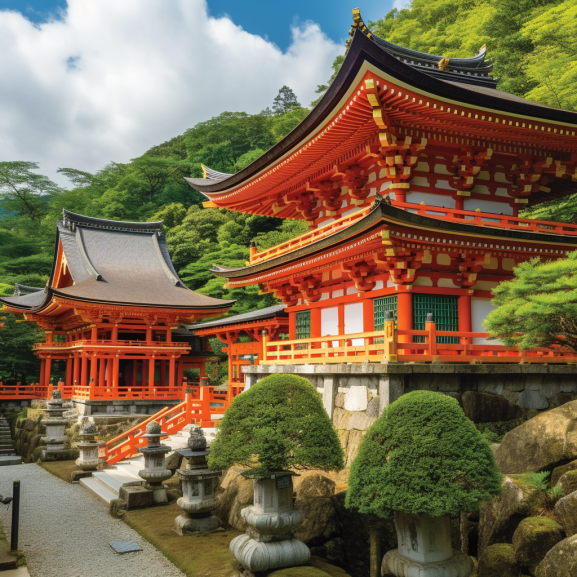Japan’s temples and shrines are a window into the country’s rich history and vibrant culture. This 2000-word blog post will take you on a journey through some of Japan’s most iconic religious sites, offering a glimpse into their significance and the customs associated with them.
Introduction
Temples and shrines are an integral part of Japanese culture. These sacred spaces, which are typically dedicated to Buddhist and Shinto deities, can be found throughout the country. They are places of worship, contemplation, and cultural preservation, and they offer visitors a unique opportunity to immerse themselves in Japanese history and tradition.
The Difference Between Temples and Shrines
Before diving into specific sites, it’s important to understand the distinction between temples and shrines. Temples, known as tera in Japanese, are Buddhist institutions. They typically house statues of Buddha and other deities and are often adorned with intricate wood carvings and vibrant paintings.
Shrines, on the other hand, are Shinto structures called jinja. They are dedicated to kami, or spirits, and they generally feature a torii gate, stone lanterns, and other distinctive elements. Visitors often cleanse themselves with water from a purification fountain before entering a shrine to show respect and purity of heart.
Now that we’ve clarified the differences, let’s explore some must-visit temples and shrines in Japan.
Kyoto: The Ancient Capital
Kinkaku-ji (The Golden Pavilion)
Located in Kyoto, Kinkaku-ji is a Zen Buddhist temple famous for its golden pavilion, which is covered in gold leaf. Originally built as a villa for a shogun, it was later converted into a temple. The serene pond and lush gardens surrounding the pavilion create a tranquil atmosphere, making Kinkaku-ji a popular spot for reflection and photography.
Kiyomizu-dera
Another iconic Kyoto temple, Kiyomizu-dera, is known for its wooden stage that juts out over a hillside, offering panoramic views of the city. The temple’s main hall houses a statue of Kannon, the goddess of mercy, and it’s said that if you can walk from one stone to another with your eyes closed, your love life will be successful.
Fushimi Inari Taisha
Fushimi Inari Taisha is a Shinto shrine famous for its thousands of vermilion torii gates, which create a seemingly endless tunnel leading up the sacred Mount Inari. The shrine is dedicated to Inari, the kami of rice and prosperity, and is a must-visit for anyone interested in Japanese culture and spirituality.
Nara: Ancient Japan’s First Permanent Capital
Todai-ji
Todai-ji, located in Nara, is a Buddhist temple renowned for its massive statue of the Vairocana Buddha, which is one of the largest bronze Buddha statues in the world. The temple is also home to an impressive collection of Buddhist art and artifacts, and its Great Buddha Hall is considered one of the architectural wonders of ancient Japan.
Kasuga Taisha
Kasuga Taisha is Nara’s most famous Shinto shrine and is known for its serene atmosphere and beautiful lanterns. The shrine is dedicated to the kami that protect the city, and its grounds are home to over 3,000 stone and bronze lanterns, which are lit during special festivals throughout the year.
Tokyo: A Mix of the Old and the New
Senso-ji
Tokyo’s oldest temple, Senso-ji, is a bustling and colorful destination located in the Asakusa district. The temple’s massive Kaminarimon gate, with
its iconic red lantern, marks the entrance to a lively shopping street leading up to the main hall. The temple is dedicated to Kannon, the goddess of mercy, and is a must-visit for anyone seeking an authentic Japanese temple experience in the heart of the city.
Meiji Jingu
Meiji Jingu is a serene Shinto shrine located in the bustling Shibuya district of Tokyo. The shrine, surrounded by a vast forest, is dedicated to Emperor Meiji and his wife, Empress Shōken. Meiji Jingu is a popular destination for weddings, and if you’re lucky, you may witness a traditional Shinto wedding ceremony during your visit.
Nikko: A UNESCO World Heritage Site
Toshogu Shrine
Nikko’s Toshogu Shrine is a breathtaking and lavishly decorated Shinto shrine dedicated to Tokugawa Ieyasu, the founder of the Tokugawa Shogunate. The shrine is known for its intricate carvings, including the famous “Three Wise Monkeys” and “Sleeping Cat” sculptures. It is also home to the sacred Yomeimon Gate, which is considered an architectural masterpiece.
Rinno-ji Temple
Nearby Toshogu Shrine, Rinno-ji is a beautiful Buddhist temple with a history dating back over 1,200 years. The temple’s Sanbutsudo Hall houses three massive gilded statues representing the Buddhas of the Three Mountains of Nikko. The serene garden surrounding the temple is perfect for quiet contemplation.
Visiting Tips and Etiquette
When visiting temples and shrines in Japan, be sure to follow proper etiquette to show respect for these sacred spaces. This includes:
- Removing your shoes before entering temple buildings
- Cleansing yourself with water at the purification fountains before entering shrines
- Refraining from speaking loudly or taking photos in designated prayer areas
- Dressing modestly, with shoulders and knees covered
Conclusion
Temples and shrines are an essential part of Japan’s history and culture, offering visitors a glimpse into the country’s religious and architectural heritage. From the ancient capitals of Kyoto and Nara to the modern metropolis of Tokyo, exploring these sacred spaces will provide you with a deeper understanding of Japan’s unique blend of tradition and modernity.

コメントを残す